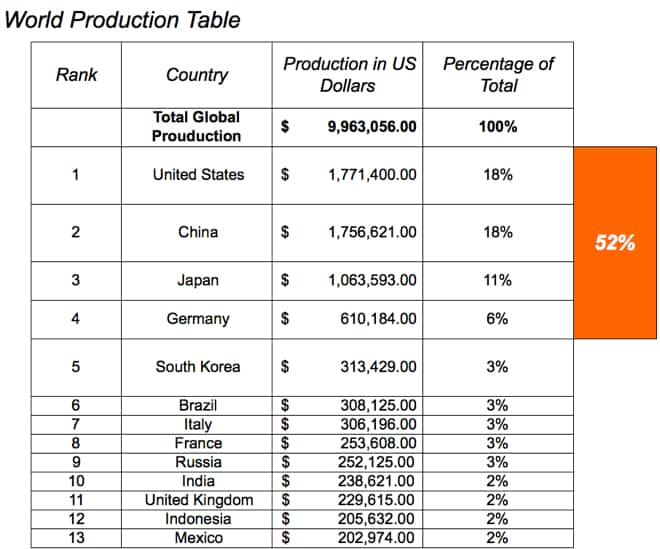Which Country Produces How Much Output?
Executive Summary
- Manufacturing is concentrated in countries with the majority of production taking place in just a few countries.

Which Country Makes How Much of Global Output?
This is a recreation of a table that can be found at Wikipedia.
See our references for this article and related articles at this link.

Interesting Features When Combined with Other Statistics
This table is interesting in some ways, which I have listed below:
- Five countries represent 1/2 of all global production.
- China, not a traditional country with a manufacturing heritage, is now as large as the US in manufacturing. China seems poised to pass the US to come to the biggest manufacturer in the world. There can also be issues with how production is valued based upon the exchange rate. China’s exchange rate is artificially set low to promote exports and to discourage imports — given this, it is most likely that China already easily surpasses the US. At one time, the US was the country that grew its production rapidly by copying manufacturing techniques and hiring British manufacturing experts. Still, there has never been such a fast transition manufacturing capacity from other nations to a single country, as in China’s case. For example, in 1950, China produced essentially no automobiles, while the US produced 8 million. In 2012 the US produced 10.3 million cars, but China produced 19.7 million.
- Despite NAFTA, the real story in the “outsourcing” of manufacturing has been China, not Mexico. Mexico only produces 2% of world output. Most of this output is just production for the US market and is, in fact, within proximity to the US border.
- With all the discussion of the decline in manufacturing in the US, this has mostly decreased manufacturing employment. This decline in employment has been steep dropping from a peak in 1939 of 30% of the economy’s employment (I removed the war period of manufacturing where employment in manufacturing reached 40% of all US employees working in manufacturing as it was artificial) to where it is now down to 9%. This has had an entirely negative effect on income inequality but has made US manufacturing the most efficient in the world. US manufacturing workers are roughly 7.5 times more productive than the same worker in 1950. In contrast, the average manufacturing worker made $10 per hour (adjusted for inflation), whereas, in 2010, the average production worker made $19 per hour. Therefore, the employee has taken about 13% of the benefit of the gain, with the remaining 87% being split between the manufacturing firm and consumers.
- The UK, where the industrial revolution began, and at one time, a dominant world manufacturer produces only 2% of the world’s output. This is probably understated somewhat as the Pound is consistently overvalued — but the UK’s currency puts UK manufacturers at a disadvantage. The UK has roughly 20% of the US population and produces around 11% of what the US produces. So roughly speaking, adjusted for the population produces 1/2 as much per person.
- Russia is a large county with some of the biggest reserves of natural resources globally; however, it does not manufacture very much, especially compared to its population size. This explains why Russia is primarily a source of raw materials for the rest of the world and not manufactured items.